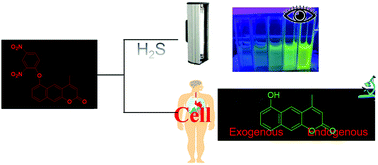As an important small gas signal molecule, H2S has become an important research hotspot for both chemists and biologists. Therefore, we designed and synthesized a benzene-conjugated coumarin connected to 2,4-dinitrobenzene via an oxygen atom (P1) to detect H2S and explored its applications in biological imaging. After 40 minutes of long-time irradiation and different pH tests, we found that P1 has good photostability and chemical stability, indicating that P1 had the ability to detect H2S accurately. In addition, P1 has a fast response speed, low detection limit and low toxicity. Based on these characteristics, P1 was used to detect H2S in live cell imaging.

